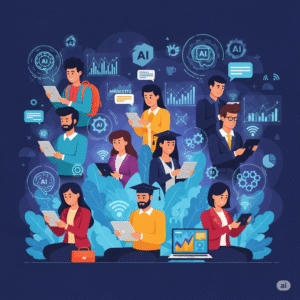AI vs Automation: Introduction
In today’s fast-paced digital world, terms like artificial intelligence (AI) and automation are often used interchangeably, leading to confusion. While both technologies aim to streamline processes and boost efficiency, they are fundamentally different in their approach and capabilities. This comprehensive guide on AI vs automation will clarify the distinctions, explore their applications, and help you understand how to leverage them effectively—whether you’re a business owner, marketer, freelancer, or curious beginner.
Understanding AI vs automation is crucial for anyone looking to adopt cutting-edge technologies to improve workflows, save time, or stay competitive. In this 1600+ word article, we’ll break down the definitions, differences, use cases, and future trends of AI and automation, ensuring you leave with a clear grasp of both concepts.
What is Automation?
Automation refers to the use of technology to perform tasks with minimal human intervention. It relies on predefined rules, scripts, or workflows to execute repetitive, predictable processes. Think of automation as a set of instructions that a machine follows to complete a task efficiently.
For example, scheduling social media posts using tools like Buffer or Hootsuite is a form of automation. The tool follows a set schedule and posts content at specific times without requiring manual input each time. Automation is ideal for tasks that are:
- Repetitive and rule-based
- Time-consuming
- Prone to human error
Examples of Automation
- Email Marketing: Sending automated welcome emails to new subscribers.
- Manufacturing: Assembly lines where robots perform repetitive tasks like welding or packaging.
- Data Entry: Software that automatically transfers data from one system to another.
Automation is about efficiency and consistency, but it lacks the ability to adapt or learn beyond its programmed instructions. This is where AI vs automation comes into play.
What is Artificial Intelligence?
Artificial Intelligence (AI) involves creating systems that can mimic human intelligence, such as learning, reasoning, problem-solving, and decision-making. Unlike automation, AI can analyze data, identify patterns, and make decisions without explicit instructions. In the context of AI vs automation, AI is dynamic and adaptive, while automation is static.
For instance, a chatbot powered by AI, like ChatGPT, can understand and respond to varied customer queries in natural language, learning from interactions to improve over time. AI systems rely on:
- Data: Large datasets to train models.
- Machine Learning (ML): A subset of AI that enables systems to learn from data.
- Neural Networks: Structures inspired by the human brain for processing complex information.
Examples of AI
- Virtual Assistants: Siri or Google Assistant interpreting voice commands.
- Recommendation Systems: Netflix suggesting shows based on viewing history.
- Predictive Analytics: AI forecasting sales trends based on past data.
In the AI vs automation debate, AI stands out for its ability to handle complex, non-linear tasks that require adaptability.
Key Differences: AI vs Automation
To fully grasp AI vs automation, let’s compare them across several dimensions:
1. Functionality
- Automation: Follows predefined rules to execute tasks. It’s rigid and doesn’t adapt to new situations.
- AI: Learns from data, adapts to changes, and makes decisions based on patterns.
2. Complexity
- Automation: Best for simple, repetitive tasks like scheduling or data sorting.
- AI: Handles complex tasks like image,KAimage recognition or natural language processing.
3. Learning Capability
- Automation: Cannot learn or improve over time.
- AI: Improves with more data and experience.
4. Human Intervention
- Automation: Requires initial setup and occasional updates but runs independently.
- AI: Can operate autonomously and refine its performance without human input.
5. Use Cases
- Automation: Email autoresponders, robotic assembly lines, automated billing systems.
- AI: Personalized recommendations, fraud detection, autonomous vehicles.
In short, AI vs automation boils down to adaptability and intelligence. Automation is like a reliable worker following a script, while AI is like a creative problem-solver that evolves.
Real-World Applications of AI vs Automation
Automation in Action
Automation shines in scenarios where consistency and speed are key. Common applications include:
- Marketing: Tools like Mailchimp automate email campaigns based on triggers like sign-ups.
- Business Operations: Software like Zapier connects apps to automate workflows, such as syncing Google Sheets with CRM systems.
- Manufacturing: Robotic arms assemble products with precision and speed.
AI in Action
AI excels in dynamic environments requiring analysis and decision-making. Examples include:
- Healthcare: AI algorithms analyze medical images to detect diseases like cancer.
- E-commerce: AI-driven chatbots provide personalized customer support.
- Finance: AI detects fraudulent transactions by analyzing spending patterns.
Hybrid Applications
In many cases, AI vs automation isn’t an either-or choice—businesses combine both for maximum impact. For example, an e-commerce platform might use automation to send order confirmation emails and AI to recommend products based on user behavior.
Benefits and Limitations: AI vs Automation
Benefits of Automation
- Cost-Effective: Reduces labor costs for repetitive tasks.
- Reliable: Performs tasks consistently without fatigue.
- Scalable: Easily applied to large-scale operations.
Limitations of Automation
- Inflexible: Cannot handle unexpected variables.
- Limited Scope: Only works within predefined parameters.
Benefits of AI
- Adaptive: Learns and improves over time.
- Versatile: Handles diverse and complex tasks.
- Insightful: Provides data-driven predictions and insights.
Limitations of AI
- Costly Development: Requires significant investment in data and expertise.
- Ethical Concerns: Potential for bias and privacy issues.
- Complexity: Can be harder to implement than automation.
When considering AI vs automation, the choice depends on your needs. Automation is ideal for straightforward, repetitive tasks, while AI is better suited for dynamic, data-driven challenges.
Tools for AI and Automation
Automation Tools
- Zapier: Connects apps to automate workflows.
- Make (Integromat): Creates complex automation sequences.
- IFTTT: Simplifies automation for smart devices and apps.
AI Tools
- ChatGPT: Generates human-like text for various applications.
- Google Cloud AI: Offers APIs for tasks like image recognition and translation.
- IBM Watson: Provides AI solutions for businesses, from analytics to chatbots.
For those exploring AI vs automation, many platforms now integrate both. For example, HubSpot uses automation for email workflows and AI for lead scoring.
How to Choose Between AI and Automation
Deciding between AI vs automation depends on your goals, budget, and technical requirements. Here are some questions to ask:
- Is the task repetitive and predictable? If yes, automation is likely sufficient.
- Does the task require data analysis or adaptability? AI is the better choice.
- What’s your budget? Automation tools are generally cheaper than AI solutions.
- Do you have access to data? AI requires large datasets to function effectively.
For small businesses or freelancers, starting with automation tools like Zapier can be a cost-effective way to streamline operations. As needs grow, integrating AI solutions can provide deeper insights and scalability.
Ethical Considerations in AI vs Automation
Automation Ethics
Automation is relatively straightforward but can lead to job displacement in industries like manufacturing. It’s important to balance efficiency with workforce considerations.
AI Ethics
AI raises more complex ethical issues, including:
- Bias: AI models can perpetuate biases in their training data.
- Privacy: AI often relies on personal data, raising consent concerns.
- Accountability: Who is responsible when AI makes a wrong decision?
When exploring AI vs automation, ensure you address these concerns by using transparent, fair systems and complying with data protection regulations.
The Future of AI vs Automation
Automation Trends
- Increased Integration: Automation tools are becoming more user-friendly and interconnected.
- IoT Expansion: The Internet of Things (IoT) will drive automation in smart homes and cities.
- Low-Code Platforms: Tools like Bubble enable non-coders to create automated workflows.
AI Trends
- No-Code AI: Platforms like Google’s Teachable Machine make AI accessible to beginners.
- Ethical AI: Efforts to reduce bias and improve transparency are gaining traction.
- AI Democratization: Affordable AI tools are empowering small businesses and individuals.
In the AI vs automation landscape, the future lies in combining both for smarter, more efficient systems. For example, AI can analyze customer data to predict behavior, while automation delivers personalized emails based on those insights.
Getting Started with AI and Automation
For Automation
- Identify Repetitive Tasks: Look for processes that take up time, like data entry or scheduling.
- Choose a Tool: Start with user-friendly platforms like Zapier or Automate.io.
- Test and Refine: Run small tests to ensure your automation works smoothly.
For AI
- Learn the Basics: Take free courses on Coursera or edX to understand AI concepts.
- Experiment with Tools: Try ChatGPT or Canva’s AI features for hands-on experience.
- Join Communities: Engage with AI enthusiasts on X or Reddit for tips and inspiration.
By starting small and scaling up, you can harness the power of AI vs automation to transform your workflow.
Conclusion
In the AI vs automation debate, there’s no one-size-fits-all answer. Automation is perfect for repetitive, rule-based tasks, offering reliability and cost-effectiveness. AI, on the other hand, excels in complex, data-driven scenarios, providing adaptability and insights. By understanding their differences, you can choose the right technology—or combine them—for your specific needs.
Whether you’re automating email campaigns or using AI to predict market trends, both technologies offer immense potential. Start exploring today, and stay ahead in the ever-evolving world of technology!
AI for Novices: All the Information You Need
How to Start Using No Code AI Tools in Your Job Without Coding



